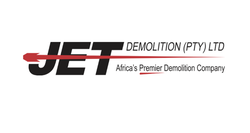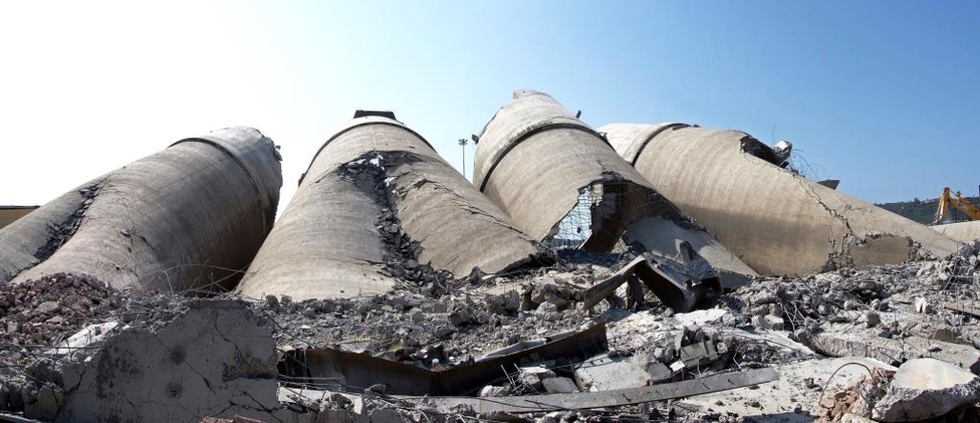Waste management is a critical part of any large-scale demolition project
| Waste management is a critical part of any large-scale demolition project | 59.5 KB | Download | |
| Asbestos abatement and removal prior to demolition | 2.24 MB | Download | |
| Downsizing of demolished concrete for in-situ rehabilitation | 2.82 MB | Download | |
| Fully rehabilitated site, returned to state of active grazing | 1.61 MB | Download | |
| Levelling and erosion control with clean, downsized demolition rubble | 249.04 KB | Download | |
| Site footprint rehabilitated with crushed material | 4.47 MB | Download | |
| Site footprint after re-use of crushed material as backfill | 4.47 MB | Download |
“The expectation is to conclude demolition quickly and cheaply, without much regard for the end use of the demolished materials. Achieving a fully-compliant site is perceived as an ideal that can only be achieved at a significant cost. However, these certifications are possible with a well-planned and carefully thought-out approach,” highlights Jet Demolition Contracts Manager Kate Bester (N. Dip. Civil Engineering).
“Waste management is a critical part of any large-scale construction or demolition project. It is vital that clients, engineers and contractors communicate clearly prior to commencement of a project to ensure alignment across all spheres. This ensures a co-operative and collaborative approach to the works, with different people actively seeking practical, cost-effective and responsible solutions to very basic problems,” comments Bester.
Therefore all roleplayers must be involved from the outset of a project, which can be achieved by determining what the thresholds are, and then seeking alternative solutions that can meet these thresholds, while still being cost-sensitive.
The vast majority of construction materials are able to be sorted and cleaned mechanically either prior to or during demolition activities. Hazardous material abatement is crucial to remove the potential risk and contaminants from a structure prior to demolition, thereby resulting in ‘clean’ rubble from a structure.
Therefore Jet Demolition always approaches a site with safety as paramount. “We will typically abate hazardous materials prior to demolition where practical, and then move on to the mechanical separation of materials during demolition,” explains Bester. Here steel is set aside and processed for delivery to a foundry for recycling. Where possible, ‘clean’ demolition rubble is used as on-site layer works or backfill to voids. Any excess material is loaded and hauled for reuse.
What about the impact on landfill sites, which are themselves under pressure? “There is no denying that a large proportion of demolition and construction rubble does go to registered landfill sites,” adds Bester. However, it is critical to note that this material is often used to rehabilitate the landfill sites themselves.
The vast majority of registered landfill sites have very strict controls over the quality and quantum of material they are able to accept. There is usually a strict grading in terms of the size limitation of the material accepted, with most material crushed prior to delivery. This material itself can then be used to cap the site, or even as an engineered fill to serve as a permeable drainage layer.
In the event that there is material that cannot be suitably downsized and cleaned prior to disposal, the surcharge on the disposal is generally very high. This is specifically done to discourage the disposal of material that could otherwise have been recycled.
The fact that ‘clean’ material goes to landfill should not necessarily result in it being classified as waste. “What may be needed is a reclassification of the different waste materials,” notes Bester. The vast majority of this material is being reused and recycled, albeit through a landfill facility for capping, a farmer for erosion control, or by local council for backfilling sinkholes. “This material is valuable, and should be seen as such,” argues Bester.
Ends
Connect with Jet Demolition on Social Media to receive the company’s latest news
Facebook: https://www.facebook.com/JetDemolition/?ref=br_rs
LinkedIn: https://www.linkedin.com/company/jet-demolition-pty-ltd/
Notes to the Editor
To download hi-res images for this release, please visit http://media.ngage.co.za and click the Jet Demolition link to view the company’s press office.
About Jet Demolition
Jet Demolition has been undertaking industrial demolition works since 1994, and is the leading, largest, and most technically-advanced demolition company in Africa. It offers in-house, full-range demolition services, including advanced mechanical solutions and controlled implosions. It actively pursues ongoing development of skills and equipment suited to the changing needs of the industry.
Jet Demolition is a technically-based company, with various staff members holding MSc, BSc, and BTech Degrees, as well as National Diplomas, in various engineering fields. This expertise gives it the technical foundation to successfully engineer solutions for large and complex demolition projects, and furthermore fuels its drive to deliver quality projects safely. Jet Demolition strives to offer its clients innovative and technical solutions to demanding demolition challenges.
Jet Demolition Contact
Kate Bester (NDip Civil Engineering)
Contracts Manager
Phone: (011) 495 3800
Cell: 072 811 5310
Email: kate [at] jetdemolition [dot] co [dot] za
Media Contact
Renay Tandy
NGAGE Public Relations
Phone: (011) 867 7763
Fax: 086 512 3352
Cell: 082 562 5088
Email: renay [at] ngage [dot] co [dot] za
Web: www.ngage.co.za
Browse the NGAGE Media Zone for more client press releases and photographs at http://media.ngage.co.za

